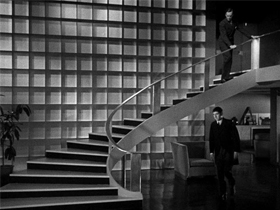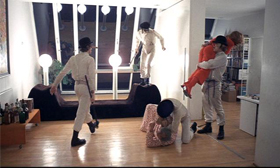

the ever-present threat
this strategy of dystopic violence achieves its effect by assaulting the sense
of security of the viewer by introducing violence into situations that
the viewer would assume to be safe. In Kubrick’s A Clockwork Orange violence enters rural enclaves through simple tricks that any decent person would fall for. By presenting violence as the potential result of being at home, the threat of violence presented through A Clockwork Orange becomes
omnipresent – setting it in extremely upscale looking homes removes
the temptation to alienate yourself from the environment.
Black Cat also uses specific architecture to effect its dystopic
message. This film has a clean, modern house as setting – deliberate portrayed as concealing. The modern façade sits over a dungeon of historic war foundations filled with satanic ritual and the embalmed corpses of female sacrifices. By
connecting violence to the cleanest, sleekest architecture of the time, Black Cat insinuates that violence could be at the core of any setting, from the haunted house you expected it in, to the minimalist sanctum espoused as the ideal living environment.
The dystopic effect of ever present threat is to hint to the viewer that the world is filled with burgeoning threats, potentially concealed behind any convenient veneer. In the dystopia of the ever present threat,
the only way to protect yourself is to be constantly on your guard, alienated
from all of treacherous humanity and incessantly investigating your environment
for holes in its façade.